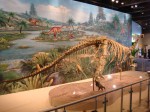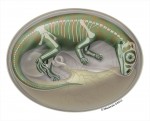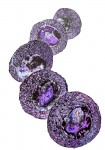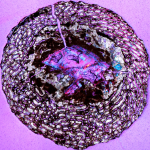 An international team of paleontologists led by University of Toronto professor Robert Reisz have unearthed an Early Jurrasic bone bed of fossilized dinosaur embryos and eggshells in China’s Lufeng County. There are more than 200 disarticulated bones of embryos at various stages of growth in the bed. They are 190 to 197 million years old, which makes them the oldest dinosaur embryos ever found. A fossilized nursery of Massospondylus dinosaurs excavated in South Africa (also by Robert Reisz and colleagues) starting in 2005 date to 190 million years ago. Until the Lufeng find, they held the record of oldest embryos ever discovered. Most of the dinosaur embryos that have been found are from the Cretaceous period (ca. 145 million to 65 million years ago).
An international team of paleontologists led by University of Toronto professor Robert Reisz have unearthed an Early Jurrasic bone bed of fossilized dinosaur embryos and eggshells in China’s Lufeng County. There are more than 200 disarticulated bones of embryos at various stages of growth in the bed. They are 190 to 197 million years old, which makes them the oldest dinosaur embryos ever found. A fossilized nursery of Massospondylus dinosaurs excavated in South Africa (also by Robert Reisz and colleagues) starting in 2005 date to 190 million years ago. Until the Lufeng find, they held the record of oldest embryos ever discovered. Most of the dinosaur embryos that have been found are from the Cretaceous period (ca. 145 million to 65 million years ago).
 Like the South African find, these embryos are also of a sauropodomorph type of dinosaur, probably Lufengosaurus, a long-necked herbivore. Unlike the Massospondylus fossils, these were not intact eggs and nests, but rather an assortment of bones and broken eggshells. This has provided researchers with an extremely valuable opportunity to study dinosaur embryology by examining the bone tissues at the cellular level. You can’t do much of that when the embryos are still locked into their complete eggs.
Like the South African find, these embryos are also of a sauropodomorph type of dinosaur, probably Lufengosaurus, a long-necked herbivore. Unlike the Massospondylus fossils, these were not intact eggs and nests, but rather an assortment of bones and broken eggshells. This has provided researchers with an extremely valuable opportunity to study dinosaur embryology by examining the bone tissues at the cellular level. You can’t do much of that when the embryos are still locked into their complete eggs.
 The bed was first discovered three years ago by a Timothy Huang, a professional chemist and amateur archaeologist. The fully excavated site is just about three feet square and only four to eight inches thick. The 200 tiny bones were all concentrated in this small area. Since they are at different stages of development, this was not a single nest. Researchers believe the spot was once near water — sauropodomorphs often laid eggs next to water so the wet sediment would keep the eggs from drying out — and that it flooded, smothering the eggs which eventually fell apart.
The bed was first discovered three years ago by a Timothy Huang, a professional chemist and amateur archaeologist. The fully excavated site is just about three feet square and only four to eight inches thick. The 200 tiny bones were all concentrated in this small area. Since they are at different stages of development, this was not a single nest. Researchers believe the spot was once near water — sauropodomorphs often laid eggs next to water so the wet sediment would keep the eggs from drying out — and that it flooded, smothering the eggs which eventually fell apart.
Upon analysis, scientists found 20 wee femurs half an inch to an inch long belonging to different embryos. The team concentrated on the fourth trochanter, a bone projection where the leg muscles attach to the thighbone, and found that Lufengosaurus developed rapidly in the egg, like modern birds and mammals rather than at the slower speeds of reptiles today. The radial growth of the femur was asymmetric, greater next to the fourth trochanter which strongly suggests the little guys were kicking around in there, developing their leg muscles and strengthening their bones before birth.
fourth trochanter which strongly suggests the little guys were kicking around in there, developing their leg muscles and strengthening their bones before birth.
[T]he tiniest femurs showed no signs of a fourth trochanter. Femurs from embryos that were a bit older had budding trochanters whose interiors were made up mostly of cartilage. And the largest, most developed femurs had big, fully hardened trochanters.
From studies of living animals such as mice, other scientists have shown that the development of trochanters and other bone processes require early muscle contraction during embryonic development.
“Lots of animals, such as birds and mammals, move inside the egg [or womb]. And of course, our babies move like crazy,” Reisz said.
That’s because “if the muscles don’t contract, the processes on the bones do not form … By comparison with living things, we can argue that [bone development in Lufengosaurus embryos] was also mediated by muscle contraction.”
 The bone tissue samples provide the oldest examples of complex organic material from a terrestrial vertebrate ever preserved in situ. It was an unexpected find because these small bonelets were porous, so you’d think they’d have been devastated by corrosion, decay and contamination. This may give paleontologists a whole new area of study to focus on going forward.
The bone tissue samples provide the oldest examples of complex organic material from a terrestrial vertebrate ever preserved in situ. It was an unexpected find because these small bonelets were porous, so you’d think they’d have been devastated by corrosion, decay and contamination. This may give paleontologists a whole new area of study to focus on going forward.
“That suggests to us that other dinosaur fossils might have organic remains,” [Reisz] says. “We just haven’t looked at them in the right ways.”